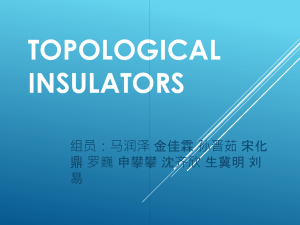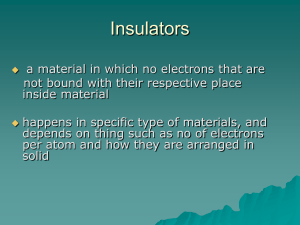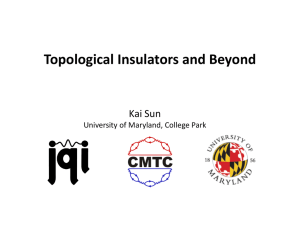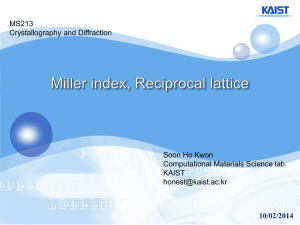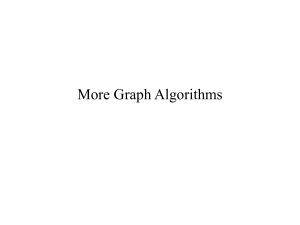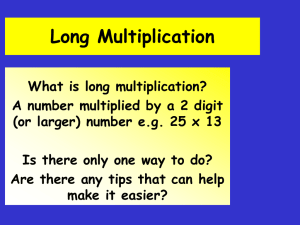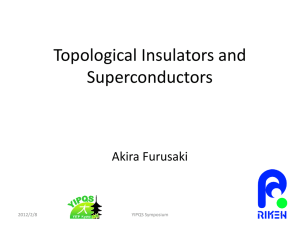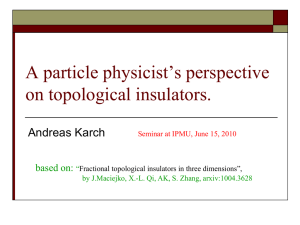Slides - Lattice 2013
advertisement
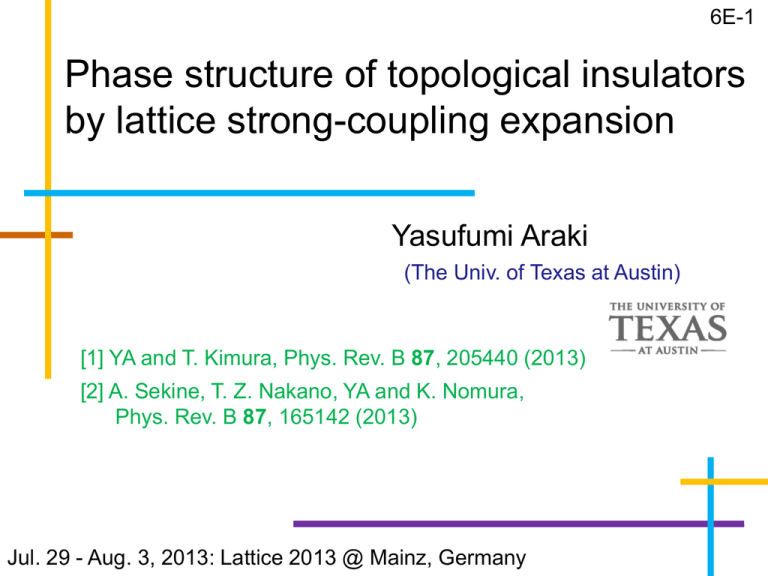
6E-1 Phase structure of topological insulators by lattice strong-coupling expansion Yasufumi Araki (The Univ. of Texas at Austin) [1] YA and T. Kimura, Phys. Rev. B 87, 205440 (2013) [2] A. Sekine, T. Z. Nakano, YA and K. Nomura, Phys. Rev. B 87, 165142 (2013) Jul. 29 - Aug. 3, 2013: Lattice 2013 @ Mainz, Germany Topological insulators “Insulator” Conduction band and valence band are separated by a large bandgap. “Topological” Wave function of electron is characterized by nontrivial topology. e.g.) Topological invariant - Chern number (Z, Z2,...) Existence of massless chiral fermions: surface states (3D) edge states (2D) - carries anomalous/spin Hall current 2005: Theoretical prediction - Kane, Mele 2007: First observed in HgTe - Konig et al. Hasan, Kane (2010) This work Question: Effect of e-e interaction on the topological nature? cf.) (Eff. theory of) graphene (2D massless Dirac fermion) Exciton condensate Analogy to “chiral symmetry breaking” in QCD spontaneous gap generation (in the bulk) Drut, Lahde (2009) Araki, Hatsuda (2010) Changes the topological band structure in TIs…? Apply lattice gauge theory … TIs can be described in terms of Wilson fermions. e-e interaction in terms of QED = U(1) gauge theory. [1] 2D topological insulators (Kane-Mele model on honeycomb lattice) [2] 3D topological insulators (Wilson fermion on square lattice) Topological phase structure changes from noninteracting systems. 2D lattice fermions Fermions on honeycomb lattice (e.g. graphene): “Dirac cone” structure around two Dirac points K±. Wallace(1947) Two Dirac nodes are degenerate: “doublers” Physical interpretation of the “mass term” K K’ = staggered magnetic field: m A-site favors ↑. / B-site favors ↓. induces antiferromagnetism in z-direction. momentum independent: nontopological mass term 2D topological insulators Kane-Mele model Kane, Mele (2005) Spin-orbit interaction (t’) is incorporated on the honeycomb lattice. Leads to “effective mass” term in the bulk becomes a “topological insulator” characterized by quantum spin Hall effect K’ K Momentum-dependent mass term Degeneracy of Dirac nodes is split by spin-orbit interaction. Analogy to the Wilson term Topological phase structure Non-interacting system: Kane, Mele (2005) m Normal insulator K (Uniform SDW) Topological insulator (Quantum spin Hall) t’ In the presence of e-e interaction…? K’ QED on honeycomb lattice [1] Incorporate e-e interaction mediated by electromagnetic field. Define QED on honeycomb lattice - apply Lattice gauge theory. Araki (2011), Giuliani et al. (2012), Buidovich et al. (2012) Electrons: (x,y) : defined on honeycomb lattice. τ : discretize by Δτ like staggered fermions. Electromagnetic field: Link variables between lattice sites. Kinetic term: given as a sum of plaquettes. proportional to “inverse coupling”: (~0.04: graphene) τ Strong coupling expansion (1) Expand the partition function by β (strong coupling expansion). (2) Integrate out the link variables. Decompose into short-range interaction terms. O(β0): on-site interaction ~ Lattice version of Hubbard model. (3) Introduce bosonic auxiliary fields. (Extended Hubbard-Stratonovich transformation) (4) Integrate out the fermionic fields. Effective potential F(σ; m, t’) Order parameters σ1(=z-direction) t’, m |σ| : imbalance between two sublattices θ : direction in the U(1) spin subspace σ : antiferromagnetism (spin density wave) σ2(=x-direction) t’ and m breaks spin symmetry in z-direction explicitly. σ1 and σ2 should be distinguished. Behavior of order parameters Fix t’=0.5t’C / Vary m=0→∞. σ2≠0 for small m. σ1→∞, σ2=0 for m→∞. tilted normal Phase diagram (σ2=0) (instead of m) (σ2=0) (σ2≠0) New phase (Tilted AF) appears by the effect of e-e interaction. Analogy to Lattice QCD 2D TIs Lattice QCD effective mass spin-orbit interaction (t’) Wilson term (r) splits degeneracy of valleys (2) doublers (16) explicitly breaks U(1) remnant spin symm. (continuous) chiral symm. Induced phase Tilted AF phase Aoki phase characterized by (nematic AF) (pion condensation) both orthogonal to the explicit breaking direction. Phase structure of topological insulators can be conjectured from lattice QCD...? 3D topological insulator [2] 2D TI: single Z2 invariant (Chern number) 3D TI: four Z2 invariants various topological phases 3D TIs (e.g. Bi2Se3) are described phenomenologically by Wilson fermions: Zhang et al. (2009) -2r < m0 < 0: “strong topological insulator” e-e interaction defined by QED (U(1) lattice gauge theory) Strong coupling expansion + Mean-field analysis Effective potential F(φσ,φπ) “pseudospin ferromagnetism” Phase structure 〈φπ〉 vanishes everywhere in the phase diagram. TI/NI transition is characterized by effective mass Strong coupling limit (r: fixed) Noninteracting limit - TI state persists in the strong coupling region. - TI/NI transition is shifted by the e-e interaction. Summary The effect of e-e interaction on topological insulators is investigated. TI band structure can be described in terms of Wilson fermions. Topological phase structure is shifted by the strong e-e interaction: 2D: new phase (“Tilted AF”) appears between TI/NI transition. 3D: TI persists at strong coupling; phase boundary is shifted. Change of physical properties under the phase transition…? anomalous (spin) Hall conductivity, existence of surface states, … Analogy to lattice QCD phase structure…? existence of “pions”? Backup slides Band strcture of graphene Tight-binding Hamiltonian: E “Dirac cone” structure at long wavelength. Wallace(1947) ... around two Dirac points K±. Gapless “semimetal” at half-filling. kx ky Effective field theory Sec. 2.1 Tight-binding Hamiltonian: λ: sublattice / τ: valley Reduced QED Sec. 2.2 Scale transformation: Saddle point approximation: Spatial components (=retardation) can be neglected. Introducing a bandgap Staggered magnetic field: Apply a spatially periodic magnetic field so that A-site favors ↑. / B-site favors ↓. Opens a finite gap m at each Dirac point. (Topology of the ground state is trivial.) Kane-Mele model Second-NN hopping = spin-orbit interaction Opens a gap at each Dirac point. Sign of “mass” depends on valley (Dirac point) index: +MSO around K+ ; -MSO around KNontrivial topology of the ground state w.f. Doubling problem and spin symmetry Sec. 2.3 Imaginary time is discretized by lattice spacing Δτ. Pole of fermion propagator appears at ω=π/Δτ as well as at ω=0. Number of d.o.f. is doubled: Doubling problem Nielsen, Ninomiya (1981) To retain the physical d.o.f.: (i) remove the spin index. (ii) treat doublers as spin d.o.f. (staggered discretization) Spin SU(2) is restricted to U(1). (defined in the (z,x)-plane) i.e. Full spin symmetry is intrinsically broken. Remnant U(1) spin is broken by SDW (antiferromagnetism). Spin and staggered representation App. A eigenvalue of Sy. Strong coupling expansion Expansion by β (strong coupling expansion) is valid. (β=0: strong coupling limit) O(β0) O(β0): on-site interaction O(β1) O(β1): NN interaction Short-range interaction terms are derived systematically. Strong coupling limit [O(β0)]: On-site 4-Fermi term is generated. ~ Lattice version of Hubbard model. Bosonic auxiliary fields: (Extended Hubbard-Stratonovich transf.) Remnant U(1) spin: σ serves as an order parameter for sublattice / spin symmetry breaking. = Antiferromagnetism (Spin Density Wave) Spontaneous symmetry breaking Thermodynamic potential: (mean field ansatz) Dirac cone structure leads to log-singularity at σ=0. Phase of σ can be chosen arbitrarily in remnant U(1). Effect of spin-orbit interaction t’ In the absence of staggered magnetic field m: Two Dirac cones interrupt each other in σ1-direction. σ1 vanishes at the potential minimum. Log singularity is moderated by the SOI gap. Order parameter σ2 gets suppressed as t’→∞. (2nd order) Physics of Tilted AF phase source: m, t’ σz1 U(1) remnant SU(2) full spinspin symmetry symmetry NG mode? Normal AF Tilted AF y σx2 Physics of NG mode: transport properties (QHE,QSHE), ...? Trajectory of potential minimum Fix t’ and vary m: 0→∞: 〈σ1〉 is induced by m explicitly. (one-to-one correspondence) 〈σ2〉 vanishes at a certain m (or σ1). Sec. 3.4.2 Trajectory of potential minimum Sec. 3.4.2 t’=0.5t’C t’=1.5t’C t’=1.0t’C σ1 monotonically increases as a function of m. Phase structure Sec. 3.4.2 Parametrize by (t’,m): Normal AF Topological Tilted AF Relation to previous studies Monte Carlo simulations of Kane-Mele-Hubbard model: (xy-antiferromagnetic insulator = “Tilted AF”) (Topological band insulator) Hohenadler et al. (2012) Our result corresponds to U→∞ limit with m-axis. 4D Quantum Hall system Sec. 3.4.2 mean displacement J. M. Edge et al. (2012) C=0 Insulator: Normal insulator C≠0 Insulator: Topological insulator Metal: Tilted AF? (effect of NG mode?) Conjecture from lattice QCD Phase structure of topological insulators can be conjectured from lattice QCD...?

